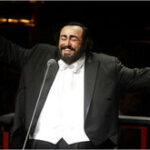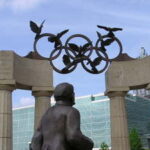In all frankness, I found it deplorable that someone found it necessary to announce to the world this week that Luciano Pavarotti lip-synched his final performance at the Winter Olympics opening ceremony in 2006. It really wasn’t that much of a mystery, as I could easily tell he was lip-synching at the time. But I felt he was allowed it because a lot of people knew his health was failing already then.
However, I was maybe duped a tad when I thought he was singing with a recording of himself as usually done in large stadiums (a process generally called “click tracking” used to enhance the voice in a large venue). Now that it’s known that the onetime greatest tenor in the world lip-synched silently to a recording of his own voice, it’s probably going to bring on a lot of vitriolic debates again about whether lip-synching should be allowed at all in the music world or if there’s any room for its acceptance in certain circumstances.
To show the differences between an American mind and a European one: Europe has been pretty much lenient on lip-synching for the last 45 years. Well, let’s not get too carried away. It’s mainly been in the U.K. and their long-running “Top of the Pops” show that was the British answer to “American Bandstand” without a Dick Clark-like host who seemed to be perfectly preserved in time. Starting already in 1964, all the classic bands who eventually invaded our shores and music stores were basically forced to lip-synch on the show. Why did they force it? Well, from available sources, it saved rehearsal time or avoided the live human voice of a rock star when they usually couldn’t duplicate how they sounded in the original studio recording.
Yep, this was anathema to the music industry who possibly were the true people behind the curtain forcing “Top of the Pops” to have their performers lip-synch.
This lack of trust in sounding like the recording has probably been the biggest blight to performances on TV that eventually evolved into Milli Vanilli-Gate in the late 1980’s. Fortunately, there seems to be factions now in those who accept lip-synching and those who only accept true live performances. It seems at least the recording industry is trying to search more lately for recording artists who can come at least as close as possible to making a live performance sound like the recording. How ironic that it seems to be the choice of the performer now here in America whether they lip-synch or not–based merely on the reality that they really don’t have much of a voice due to the evolution of an exhausted talent pool.
Click-tracking and the Queen of dubbing in movie musicals…
A lot of stars in movie musicals were either glad or chagrined that lip-synching capability was available already during the beginning of the talkie era. Some of the most blatant cases of lip-synching happened in movie musicals of yore. The reason it was so controversial was that most of the movie public had no clue how it was done then unless they worked in the industry. Most people figured the stars were singing and with their own voices at that. One of the best-known female voices who dubbed many a female star of movie musicals was Marni Nixon who’s still living at the time of this article. She managed to convince millions that legendary actresses Margaret O’ Brien, Deborah Kerr, Natalie Wood and Audrey Hepburn could sing not only good but great in some of the world’s best-known movie musicals.
The sad part of Hollywood having these stars dubbed is that many of them could sing just fine. But Hollywood wanted too much perfection in a voice then (or the belief the star was, yes…an angel) rather than letting an actress sing naturally. Nixon’s credits (which go beyond the stars I mentioned above) were kept quiet for decades until it was finally revealed in the home video era and the movies were released with documentaries blowing away all the built-up myths.
It’s too bad that a more accepted naturalness in singing started just when movie musicals were starting to go out of style. Now when you see the rare movie musical made, you’re hearing the real voices of the stars (e.g. Johnny Depp in “Sweeney Todd”) rough edges and all. And you want rough edges to a voice if you want a movie musical to succeed to a modern audience who already struggle at times with suspension of disbelief in musicals for the big screen.
Once the age of performers performing in giant stadiums started during the era when the Olympics and the Super Bowl became TV behemoths, technical challenges were posed to get the voice to reflect better in a venue holding close to 100,000 people. The process of click tracking was already around in the movie business from the very beginning of the sound era as general lip-synching was. It started out as just a synchronization tool to assist the orchestra doing the film score. And, it usually gets creation credit via Looney Tunes composer Carl Stalling, even though some say others created the system. By the 1980’s, though, it was a synthesized process that could enable a singer who wanted their voice to project more in a stadium to basically sing with themselves.
One of the most famous demonstrations of modern click-tracking was when Whitney Houston sang the National Anthem at the 1991 Super Bowl. No, Whitney’s voice wasn’t quite that powerful. Her voice doubled over, however, created a powerhouse. Nevertheless, her “live” singing voice was turned way down-and the recorded studio version of her voice was turned up. That gives the better illusion of real singing.
And that’s how most of all of today’s Tweenie pop stars–who rely on a studio to make them sound decent–make themselves sound so good in live concerts. Yes, they’re singing, but…not really via a conveniently turned-down microphone. Let the continued debates commence.
When lip-synching should be allowed and when it shouldn’t…
So many recent pop stars have been caught red-handed doing lip-synching in the 2000’s that it seems the public have become used to the process. Many just say that the overall ambiance of a live show is what matters and not whether someone can sing or not. If that’s true, then the art of real singing is dead. Well, that shouldn’t be said, because I’m noticing a trend in the last year or two toward allowing more pop singers to sing without lip-synching–vocal warts and all.
The only problem with that is…you start to wish for lip-synching coming back when you realize how bad their singing really is without studio tricks. At least vocal honesty is starting to shine through.
I’ll go out on a limb and say that when a pop star does a lot of dancing, they have no choice but to lip-synch as they never hesitate to do and because singing while out of breath is dangerous. I’ll also go out on a limb and say from an artistic perspective that I’ve been suckered into enjoying a show where there’s a lot of dancing, eye-popping set designs…yet zero real singing. In that regard, we may have to start looking at the performing arts as an amalgam of things rather than feeling let down when one part of it isn’t up to what we consider real. Even though people resist more now, applying a suspension of disbelief at a show like that is almost essential without storming out and asking for your money back.
Thank God, anyway, that the late-night shows still require pop stars to sing live. If they don’t, it’s caught immediately thanks to no one to date being able to lip perfectly to a song. Even The Beatles deliberately screwed up their lip-synching on “Top of the Pops” in the 1960’s to show their disdain of the process.
____
I think we can forgive Pavarotti in death for lip-synching once at the Olympics when he already had an incredible array of very live performances in the annals of TV history. While our recent pop singers seem to finally be singing live more lately–you can’t help but wonder what they’ll think 30 years from now when they look back on their career and see that they lipped a song during a certain era when being vocally and studio perfect wouldn’t have made all that much difference in keeping up their reputation or record sales.






